S2W Quaxar CDF
The web format of this guide reflects the most current release. Guides for older iterations are available in PDF format.
Integration Details
ThreatQuotient provides the following details for this integration:
| Current Integration Version | 1.0.0 |
| Compatible with ThreatQ Versions | >= 5.12.1 |
| Support Tier | ThreatQ Supported |
Introduction
S2W Quaxar is a multi-domain cyber threat intelligence platform specializing in hidden channels and dark web intelligence. S2W provides a wide range of intelligence services, including dark web monitoring, threat intelligence, and cyber risk management. The Quaxar platform provides tailored intelligence to help organizations identify and mitigate threats to their business.
The S2W Quaxar CDF for ThreatQ enables the automatic ingestion of customized threat intelligence from Quaxar into ThreatQ. This may include leaked credentials, threat actor profiles, vulnerability reports, indicators, and much more. Ultimately, this integration allows organizations to better understand their attack surface and proactively defend against threats, by providing analysts the information they need to make informed decisions.
The integration provides the following feeds:
- S2W Quaxar - Threat Reports - ingests Threat Reports from S2W Quaxar, into ThreatQ
- S2W Quaxar - Vulnerability Reports - ingests Vulnerability Reports from S2W Quaxar, into ThreatQ
- S2W Quaxar - Indicator Reports - ingests Indicator Reports from S2W Quaxar, into ThreatQ
- S2W Quaxar - Talon Reports - ingests Talon Reports from S2W Quaxar, into ThreatQ
- S2W Quaxar - Threat Actors - ingests Actor Profiles from S2W Quaxar, into ThreatQ
- S2W Quaxar - Ransomware Activity - ingests organizations (identities) that have been affected by ransomware, from S2W Quaxar, into ThreatQ
- S2W Quaxar - Brand Impersonation Sites - ingests indicators associated with brand impersonation sites, from S2W Quaxar, into ThreatQ
- S2W Quaxar - Leaked Credit Cards - ingests Leaked Credit Cards as Indicators (type: String), from S2W Quaxar, into ThreatQ
- S2W Quaxar - Leaked Accounts - ingests leaked accounts (identities), from S2W Quaxar, into ThreatQ
- S2W Quaxar - Exposed Assets - ingests exposed asset alerts from the S2W Quaxar Attack Surface Management module, into ThreatQ
- S2W Quaxar - Signature Vault - ingests Snort & YARA signatures from the S2W Quaxar Signature Vault module, into ThreatQ
- S2W Quaxar - Indicators - ingests indicators from S2W Quaxar, into ThreatQ
The integration ingests the following system objects:
|
|
Prerequisites
The following is required to install and run the integration:
- A S2W Quaxar License and API Credentials.
Depending on your license, you may not have access to all of the feeds included in the integration.
- ThreatQ Custom Objects:
- Compromised Account
- Compromised Card
Installing the Custom Objects
The integration requires the Compromised Account and Compromised Card custom objects. These custom objects must be installed prior to installing the CDF. ThreatQuotient provides an install script to simplify the custom object installation process.
Use the steps provided to install the required custom objects.
When installing the custom objects, be aware that any in-progress feed runs will be cancelled, and the API will be in maintenance mode.
Use the following steps to install the custom objects in ThreatQ v6:
- Download the integration bundle from the ThreatQ Marketplace.
- Unzip the bundle and locate the custom object files.
The custom object files will typically consist of a JSON definition file, install.sh script, and a images folder containing the svg icons.
- SSH into your ThreatQ instance.
- Navigate to the following location:
cd /var/lib/threatq/misc/
- Upload the custom object files, including the images folder.
The directory structure should be as the following:
- misc
- install.sh
- <custom_object_name>.json
- images (directory)
- <custom_object_name>.svg
- misc
- Run the following command:
kubectl exec -it deployment/api-schedule-run -n threatq -- sh /var/lib/threatq/misc/install.sh /var/lib/threatq/misc
The installation script will automatically put the application into maintenance mode, move the files to their required directories, install the custom object, update permissions, bring the application out of maintenance mode, and restart dynamo.
- Delete the install.sh, definition json file, and images directory from the
miscdirectory after the object has been installed as these files are no longer needed.
Use the following steps to install the custom objects in ThreatQ v5:
- Download the integration zip file from the ThreatQ Marketplace and unzip its contents.
- SSH into your ThreatQ instance.
- Navigate to tmp directory:
cd /tmp/
- Create a new directory:
mkdir s2w_cdf
- Upload the s2w.json and install.sh script into this new directory.
- Create a new directory called images within the s2w_cdf directory.
mkdir images
- Upload the svg files.
- Navigate to the /tmp/s2w_cdf.
The directory should resemble the following:
- tmp
- s2w_cdf
- s2w.json
- install.sh
- images
- account.svg
- CompromisedCard.svg
- s2w_cdf
- tmp
- Run the following command to ensure that you have the proper permissions to install the custom object:
chmod +x install.sh
- Run the following command:
sudo ./install.sh
You must be in the directory level that houses the install.sh and json files when running this command.
The installation script will automatically put the application into maintenance mode, move the files to their required directories, install the custom object, update permissions, bring the application out of maintenance mode, and restart dynamo.
- Remove the temporary directory, after the custom object has been installed, as the files are no longer needed:
rm -rf s2w_cdf
Installation
The integration requires two custom objects: Compromised Card and Compromised Account. These customs objects must be installed prior to attempting to install the integration. The required files for these custom objects have been bundled with the marketplace download for the integration and the steps to install these objects are provided in the Prerequisites section of this guide.
Perform the following steps to install the integration:
The same steps can be used to upgrade the integration to a new version.
- Log into https://marketplace.threatq.com/.
- Locate and download the integration zip file and extract its contents.
- Install the required Compromised Card and Compromised Account custom objects.
- Navigate to the integrations management page on your ThreatQ instance.
- Click on the Add New Integration button.
- Upload the integration file using one of the following methods:
- Drag and drop the yaml file into the dialog box
- Select Click to Browse to locate the yaml file on your local machine
- Select the feeds to install, when prompted, and click Install. The feed(s) will be added to the integrations page.
ThreatQ will inform you if the feed already exists on the platform and will require user confirmation before proceeding. ThreatQ will also inform you if the new version of the feed contains changes to the user configuration. The new user configurations will overwrite the existing ones for the feed and will require user confirmation before proceeding.
You will still need to configure and then enable the feed(s).
Configuration
ThreatQuotient does not issue API keys for third-party vendors. Contact the specific vendor to obtain API keys and other integration-related credentials.
To configure the integration:
- Navigate to your integrations management page in ThreatQ.
- Select the Commercial option from the Category dropdown (optional).
If you are installing the integration for the first time, it will be located under the Disabled tab.
- Click on the integration entry to open its details page.
- Enter the following parameters under the Configuration tab:
S2W Quaxar Reports Feeds
The parameters in the table below are for the following feeds: S2W Quaxar - Threat Reports, S2W Quaxar - Vulnerability Reports, S2W Quaxar - Indicator Reports, and S2W Quaxar - Talon Reports.
Parameter Description API Key Enter your S2W Quaxar API Key. Risk Filter Select the risk levels for the intel to ingest into ThreatQ. Options include: - Low
- Medium (default)
- High (default)
Context Filter Select the pieces of context to bring into ThreatQ. This allows you to filter out context that your organization may not utilize. Options include: - Report Type (default)
- Risk Score (default)
- Target Countries (default)
- Target Sectors (default)
- Target Regions (default)
- Affected Products (default)
Relationship Context Filter Select the relationships to bring into ThreatQ. This allows you to filter out context that your organization may not utilize. Options include: - Indicators (default)
- Adversaries (default)
- Attack Patterns (default)
- Campaigns
- Incidents
- Identities
- Organizations (Identities)
- Intrusion Sets
- Malware (default)
- Tools (default)
- TTPs (default)
- Vulnerabilities (default)
Indicator Type Filter Select the indicator types to bring into ThreatQ. This allows you to filter out indicator types that your organization may not utilize. This field will only display if the
Options include:Indicatorsoption is selected within the Relationship Context Filter field.- IPv4 Address (default)
- IPv6 Address (default)
- FQDN (default)
- URL (default)
- Email Address (default)
- MD5 (default)
- SHA-1 (default)
- SHA-256 (default)
- HA-512 (default)
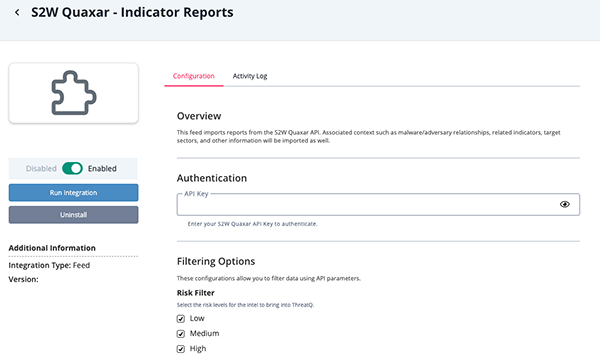
S2W Quaxar - Threat Actors
Parameter Description API Key Enter your S2W Quaxar API Key. Threat Actor Type Filter Select the threat actor types to bring into ThreatQ. This allows you to filter out threat actor types that your organization may not utilize. Options include: - APT (default)
- Ransomware (default)
- Criminal (default)
Context Filter Select the pieces of context to bring into ThreatQ. This allows you to filter out context that your organization may not utilize. Options include: - Threat Actor Types (default)
- Aliases (default)
- Target Countries (default)
- Target Sectors (default)
- Origins (default)
Relationship Context Filter Select the relationships to bring into ThreatQ. This allows you to filter out context that your organization may not utilize. Options include: - Indicators (default)
- Attack Patterns (default)
- Malware (default)
- Tools (default)
- Vulnerabilities (default)
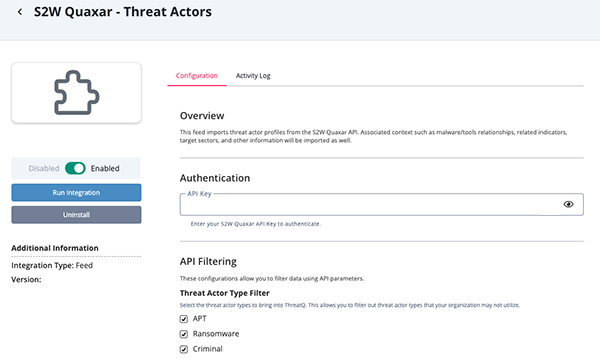
S2W Quaxar - Ransomware Activity
Parameter Description API Key Enter your S2W Quaxar API Key.
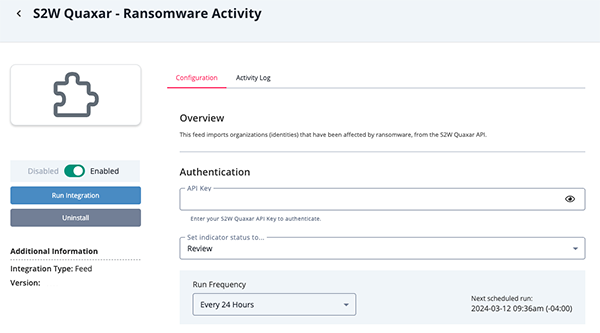
S2W Quaxar - Brand Impersonation Sites
Parameter Description API Key Enter your S2W Quaxar API Key. Type Filter Select the brand impersonation types to bring into ThreatQ. This allows you to filter out brand impersonation types that your organization is concerned about. Options include: - Affiliate Fraud (default)
- Brand Abusing (default)
- Credential Phishing (default) Ecommerce
- Fraud (default)
- Look ALike Domain (default)
- Phishing Domain (default)
- Unapproved Application (default)
- Voice Phishing (default)
Risk Filter Select the risk levels for the alerts to bring into ThreatQ. Options include: - Unknown
- Parking
- Suspicious
- Low
- Medium (default)
- High (default)
Executable Hash Types Select the hash types to ingest for the related executables. Selecting none will not ingest any hashes for the executables. Options include: - MD5
- SHA-1
- SHA-256
Ingest Domain of Brand Impersonation URLs Select whether or not to ingest the domains associated with the brand impersonation URLs. This parameter is enabled by default. Default Domain Status Select the default status for the domain. This defaults to Review because the domain may be legitimate. This option only displays if the
Option include:Ingest Domain of Brand Impersonation URLsoption is enabled.- Review (default)
- Active
- Indirect
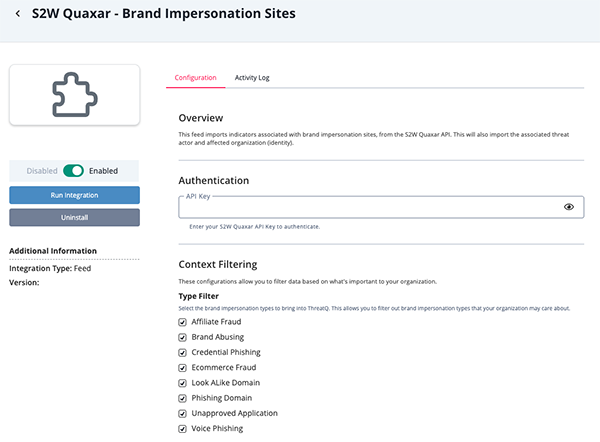
S2W Quaxar - Leaked Credit Cards
Parameter Description API Key Enter your S2W Quaxar API Key.
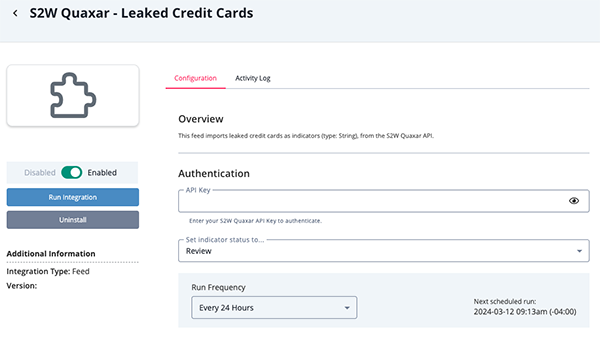
S2W Quaxar - Leaked Accounts
Parameter Description API Key Enter your S2W Quaxar API Key. Context Filter Select the pieces of context to bring into ThreatQ. This allows you to filter out context that your organization may not utilize. Options include: - Leak Source (default)
- Associated Site (default)
- Victim IP
- Victim Country (default)
- Exposed Password
- Exposed At (default)
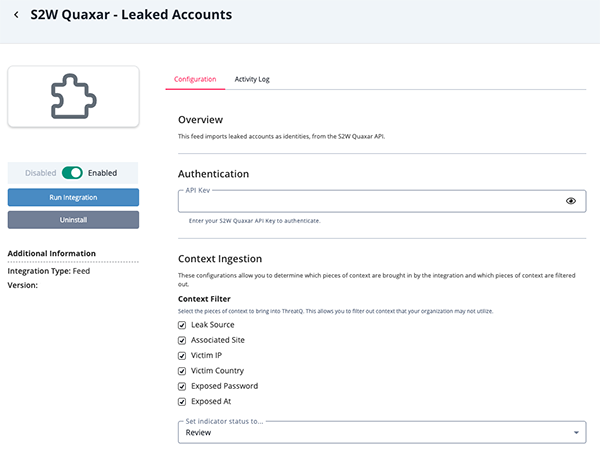
S2W Quaxar - Exposed Assets
Parameter Description API Key Enter your S2W Quaxar API Key. Event Context Filter Select the pieces of context to bring into ThreatQ. This allows you to filter out context that your organization may not utilize. Options include: - Organization (default)
- Notes (default)
Asset Context Filter Select the pieces of asset context to bring into ThreatQ. This allows you to filter out context that your organization may not utilize. Options include: - City (default)
- Country (default)
- ASN
- ASN Organization
- Region
- Latitude
- Longitude
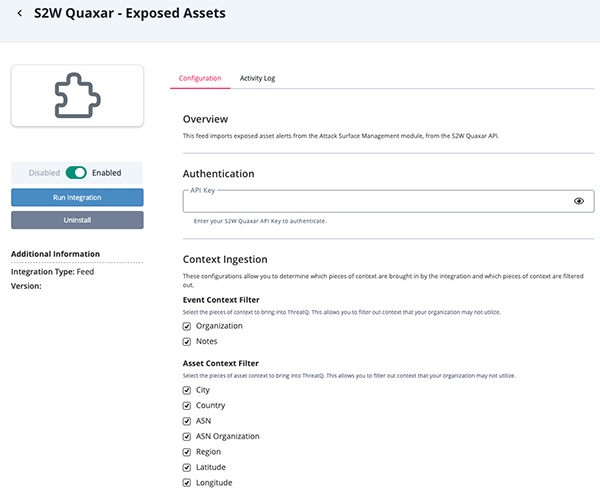
S2W Quaxar - Signature Vault
Parameter Description API Key Enter your S2W Quaxar API Key. Type Filter Select the signature types to bring into ThreatQ. This allows you to filter out signature types your organization may not utilize. Options include: - YARA (default)
- Snort (default)
Relationship Context Filter Select the relationship context to bring into ThreatQ. This allows you to filter out context that your organization may not utilize. Options include: - Campaigns (Attribute) (default)
- Malware (default) T
- hreat Actors (default)
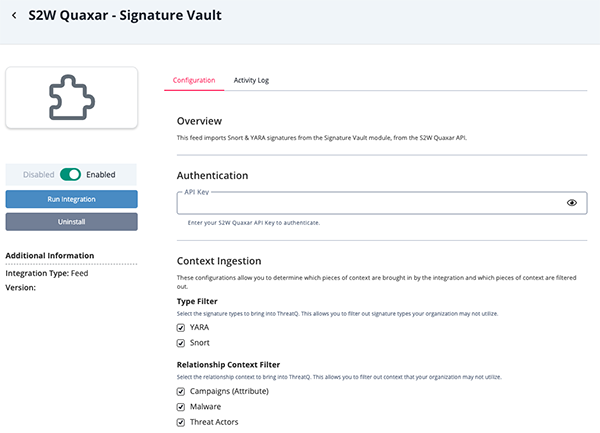
S2W Quaxar - Indicators
Parameter Description API Key Enter your S2W Quaxar API Key. Risk Filter Select the risk levels for the intel to bring into ThreatQ. Options include: - Low
- Medium (default)
- High (default)
Context Filter Select the pieces of context to bring into ThreatQ. This allows you to filter out context that your organization may not utilize. Options include: - Categories (default)
- Confidence (default)
- Recommend
- Risk Score (default)
- Original Sources
- Countries (default)
Relationship Context Filter Select the relationship context to bring into ThreatQ. This allows you to filter out context that your organization may not utilize. Options include: - Campaigns (Attribute)
- Malware (default)
- Threat Actors (default)
- Tools (default)
- Attack Patterns (default)
- Vulnerabilities (default)
Indicator Type Filter Select the indicator types to bring into ThreatQ. This allows you to filter out indicator types that your organization may not utilize. Options include: - IPv4 Address (default)
- IPv6 Address (default)
- FQDN (default)
- URL (default)
- Email Address (default)
- MD5 (default)
- SHA-1 (default)
- SHA-256 (default)
- SHA-512 (default)
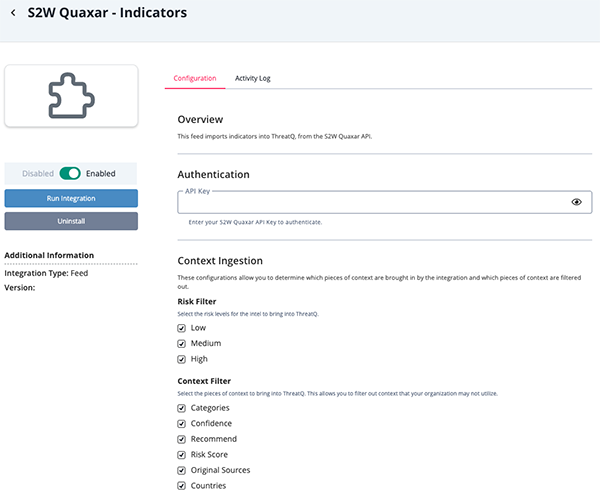
- Review any additional settings, make any changes if needed, and click on Save.
- Click on the toggle switch, located above the Additional Information section, to enable it.
ThreatQ Mapping
S2W Quaxar Report Feeds
The following feeds are included in the Reports feeds:
- S2W Quaxar - Threat Reports
- S2W Quaxar - Vulnerability Reports
- S2W Quaxar - Indicator Reports
- S2W Quaxar - Talon Reports
The Report feed periodically pulls reports from S2W Quaxar, into ThreatQ. The intelligence is ingested as Report objects, along with all of the related contextual data such as Indicators, Adversaries, Malware, as well as other objects within the STIX 2 data model.
GET https://api.quaxar.io/report/list
Sample Response:
{
"total": 86,
"data": [
{
"doclink": "https://portal.quaxar.io/knowledgebase/document/report--155435f8-f4e3-43ae-bea5-1c787f81400b",
"id": "report--155435f8-f4e3-43ae-bea5-1c787f81400b",
"type": "vulnerability",
"published": 1700499284000,
"title": "Kinsing malware exploits Apache ActiveMQ RCE to plant rootkits",
"body": "The Kinsing malware operator is actively exploiting the CVE-2023-46604 critical vulnerability in the Apache ActiveMQ open-source message broker to compromise Linux systems.\nThe flaw allowsremote code execution and was fixed in late October. Apache’s disclosure explains that the issue allows running arbitrary shell commands leveraging serialized cla...",
"riskscore": 1,
"tags": [
{
"id": "malware--85ee128f-6bb5-11eb-b195-b02628e2a7a1",
"type": "malware",
"name": "HELLOKITTY",
"description": "[HELLOKITTY](https://attack.mitre.org/software/S0617) is a ransomware written in C++ that shares similar code structure and functionality with [DEATHRANSOM](https://attack.mitre.org/software/S0616) and [FIVEHANDS](https://attack.mitre.org/software/S0618). [HELLOKITTY](https://attack.mitre.org/software/S0617) has been used since at least 2020, targets have included a Polish video game developer and a Brazilian electric power company.(Citation: FireEye FiveHands April 2021)"
},
{
"id": "vulnerability--163ed800-74f0-11ee-96a4-b02628e2a7a1",
"type": "vulnerability",
"name": "CVE-2023-46604",
"description": "The Java OpenWire protocol marshaller is vulnerable to Remote Code \nExecution. This vulnerability may allow a remote attacker with network \naccess to either a Java-based OpenWire broker or client to run arbitrary\n shell commands by manipulating serialized class types in the OpenWire \nprotocol to cause either the client or the broker (respectively) to \ninstantiate any class on the classpath.\n\nUsers are recommended to upgrade\n both brokers and clients to version 5.15.16, 5.16.7, 5.17.6, or 5.18.3 \nwhich fixes this issue.\n\n"
}
],
"reference": "https://www.bleepingcomputer.com/news/security/kinsing-malware-exploits-apache-activemq-rce-to-plant-rootkits/",
"indicators": []
},
{
"doclink": "https://portal.quaxar.io/knowledgebase/document/report--659162d4-8794-11ee-96a4-b02628e2a7a1",
"id": "report--659162d4-8794-11ee-96a4-b02628e2a7a1",
"type": "indicator",
"published": 1700477782467,
"title": "Suspected Rattlesnake organization uses Nim backdoor to spy on intelligence from many countries in South Asia",
"body": "Sidewinder, also known as Sidewinder, QiAnXin internal tracking number APT-Q-39. This organization is generally believed to have a background in South Asia and was disclosed by domestic and foreign security vendors in 2018. Its earliest attack activities can be traced back to 2012. The organization's attack targets are generally government and mili...",
"riskscore": 1,
"tags": [
{
"id": "attack-pattern--65fbff07-5f97-11eb-b195-b02628e2a7a1",
"type": "attack-pattern",
"name": "Mshta",
"label": "T1170"
}
],
"reference": "https://mp.weixin.qq.com/s?__biz=MzI2MDc2MDA4OA==&mid=2247508655&idx=1&sn=b808c9a435b473e5dc957d1b34a79432&chksm=ea6655d8dd11dcce5db489b200b67463f251c5900402b9a1cb18c9e1d9d1c56adee066eb165e&scene=178&cur_album_id=1539799351089283075#rd",
"indicators": [
{
"id": "file--6757dfb6-2049-582e-a75c-0432ae34ec67",
"type": "SHA-256",
"name": "1409f9d855c06f66fb7d7c7bf9f821b5d1631da926b07dcdb260606e09763ad3"
},
{
"id": "file--06a9ffbb-3fb7-556d-b648-73defd4f50f5",
"type": "MD5",
"name": "92612dc223e8f0656512cd882d66f78b"
}
]
}
]
}ThreatQuotient provides the following default mapping for this feed:
Mapping is based on each item within the .data[] list in the JSON response.
| Feed Data Path | ThreatQ Entity | ThreatQ Object Type or Attribute Key | Published Date | Examples | Notes |
|---|---|---|---|---|---|
.title |
Report Value | N/A | .published |
N/A | N/A |
.body |
Report Description | N/A | N/A | N/A | Description includes some report metadata as well; HTML formatted |
.indicators[].name |
Related Indicator Value | .indicators[].type |
.published |
142.50.15.123 |
Indicator type mapped to ThreatQ types |
.tags[].name |
Related Adversary Name | N/A | .published |
WIZARD SPIDER |
Where .type == threat-actor |
.tags[].label, .tags[].name |
Related Attack Pattern Value | N/A | .published |
T1001 - Some technique |
Where .type == attack-pattern |
.tags[].name |
Attribute | Campaign | .published |
OpIsrael |
Where .type == campaign |
.tags[].name |
Related Identity Value | N/A | .published |
Tim Cook |
Where .type == identity |
.tags[].name |
Related Tool Value | N/A | .published |
psexec |
Where .type == tool |
.tags[].name |
Related Intrusion Set Value | N/A | .published |
APT1 |
Where .type == intrusion-set |
.tags[].name |
Related Malware Value | N/A | .published |
Lockbit 2.0 |
Where .type == malware |
.tags[].name |
Related TTP Value | N/A | .published |
N/A | Where .type == ttp |
.tags[].name |
Related Vulnerability Value | N/A | .published |
CVE-2024-12345 |
Where .type == vulnerability; May be a CVE or other Vulnerability description |
.tags[].name |
Attribute | Target Country | .published |
USA |
Where .type == country |
.tags[].name |
Attribute | Target Sector | .published |
Energy |
Where .type == sector |
.tags[].name |
Attribute | Target Region | .published |
Middle East |
Where .type == region |
.tags[].name |
Attribute | Affected Product | .published |
Apache |
Where .type == software |
.tags[].name |
Related Identity Value | N/A | .published |
Acme Corp |
Where .type == organization |
| N/A | Attribute | Report Type | .published |
threat-report |
Static based on feed |
.riskscore |
Attribute | Risk Score | .published |
1 |
N/A |
S2W Quaxar - Threat Actors
The Threat Actors feed periodically pulls Threat Actor profiles from S2W Quaxar. Using this feed, you can stay up-to-date with APTs, Ransomware Groups, and other Criminal Actors. You'll be able to identify their aliases, target countries/sectors, and other relevant information such as relationships to Indicators, Tools, and more.
GET https://api.quaxar.io/tap/list
Sample Response:
{
"total": 84,
"data": [
{
"id": "group-threat-actor--f9a8d088-b8fb-410a-b7ae-39ca04479e42",
"name": "SecretCrow",
"types": [],
"origins": [],
"countries": ["South Korea"],
"sectors": [],
"aliases": [],
"last_updated": 1700457942000
},
{
"id": "group-threat-actor--7bc634a9-852b-11ee-96a4-b02628e2a7a1",
"name": "spider",
"types": [],
"origins": [],
"countries": [],
"sectors": [],
"aliases": [],
"last_updated": 1700409277641
}
]
}See the Get Actor by ID supplemental feed for mapping information.
S2W Quaxar - Get Actor by ID (Supplemental)
This supplemental feed will pull an individual actor's full details from the Quaxar API by ID.
GET https://api.quaxar.io/tap/{{ id }}
Sample Response:
{
"id": "group-threat-actor--a1f64882-7dd3-423c-b191-f44a5ee6eddf",
"name": "LockBit",
"types": ["ransomware"],
"origins": [],
"countries": [
"Brazil",
"Venezuela",
"Canada",
"Japan",
"Poland",
"Taiwan",
"Thailand"
],
"sectors": [
"Defense",
"BFSI",
"software",
"Government",
"Research",
"Healthcare",
"Automotive"
],
"aliases": [
{
"name": "LockbitSupp",
"id": "threat-actor--8e549f69-3700-458c-934c-20c791a574a6"
}
],
"malwares": [
{
"name": "aukill",
"id": "malware--f751f1cf-dea6-11ed-96a4-b02628e2a7a1"
},
{
"name": "LockBit",
"id": "malware--43d726db-0f53-44a2-a170-a696d9cbe359"
}
],
"tools": [
{
"name": "AdFind",
"id": "tool--f59508a6-3615-47c3-b493-6676e1a39a87"
},
{
"name": "PCHunter",
"id": "tool--f7e5be1e-d4ea-495b-81b7-87dcc9c3b38e"
},
{
"name": "Mimikatz",
"id": "tool--afc079f3-c0ea-4096-b75d-3f05338b7f60"
}
],
"vulnerabilities": [
{
"name": "CVE-2023-20269",
"id": "vulnerability--a4763cd1-4cf2-11ee-96a4-b02628e2a7a1"
},
{
"name": "CVE-2018-13379",
"id": "vulnerability--57019d58-9ca8-46ba-b261-ef85cdeee215"
}
],
"attackpatterns": [
{
"name": "PowerShell",
"mitre_id": "T1059.001",
"id": "attack-pattern--970a3432-3237-47ad-bcca-7d8cbb217736"
},
{
"name": "Windows Command Shell",
"mitre_id": "T1059.003",
"id": "attack-pattern--d1fcf083-a721-4223-aedf-bf8960798d62"
}
],
"indicators": [
{
"id": "url--32c3b723-3469-58c2-91ae-c1d70b3062db",
"type": "url",
"value": "http://lockbit7z55tuwaflw2c7torcryobdvhkcgvivhflyndyvcrexafssad.onion"
},
{
"id": "file--eadd8705-0548-5f22-a308-fc62ce13ceb8",
"type": "SHA-256",
"value": "0f9677642599cf23aafe225ee2dbe403f305dc5801298b83ba19f6b939a8f914"
}
],
"reports": [
{
"name": "Canadian government discloses data breach after contractor hacks",
"published": 1700500988000,
"qxrlink": "https://portal.quaxar.io/knowledgebase/document/report--7b68c65a-3ae9-4dd3-85a1-746e7d559d06"
},
{
"name": "20th November – Threat Intelligence Report",
"published": 1700438400000,
"qxrlink": "https://portal.quaxar.io/knowledgebase/document/report--7290e021-b4e7-41ea-9d91-70704405cd92"
}
],
"last_updated": 1700500988000
}ThreatQ provides the following default mapping for this feed:
| Feed Data Path | ThreatQ Entity | ThreatQ Object Type or Attribute Key | Published Date | Examples | Notes |
|---|---|---|---|---|---|
.name |
Adversary Name | N/A | .last_updated |
CommentCrew |
N/A |
.attackpatterns[].mitre_id, .attackpatterns[].name |
Related Attack Pattern Value | N/A | .last_updated |
T1001 - Some technique |
N/A |
.vulnerabilities[].name |
Related Vulnerability Value | N/A | .last_updated |
CVE-2024-12345 |
N/A |
.tools[].name |
Related Tool Value | N/A | .last_updated |
psexec |
N/A |
.malwares[].name |
Related Malware Value | N/A | .last_updated |
WannaCry |
N/A |
.aliases[].name |
Attribute | Alias | .last_updated |
WIZARD SPIDER |
N/A |
.aliases[].types |
Attribute | Threat Actor Type | .last_updated |
ransomware |
N/A |
.indicators[].value |
Related Indicator Value | .indicators[].type |
.last_updated |
54.123.76.90 |
N/A |
.countries[] |
Attribute | Target Country | .last_updated |
USA |
N/A |
.origins[] |
Attribute | Origin | .last_updated |
North Korea |
N/A |
.sectors[] |
Attribute | Target Sector | .last_updated |
Government |
N/A |
S2W Quaxar - Ransomware Activity
The Ransomware Actitivty feed periodically pulls a list of Organizations that have been impacted by Ransomware, from S2W Quaxar. Using this feed, you can stay up-to-date with the latest Ransomware activity to better understand your organization's attack surface. Affected organizations will be ingested as Identity objects, with an attribute of Detection: Ransomware Activity
GET https://api.quaxar.io/ram/list
Sample Response:
{
"total": 230,
"data": [
{
"id": "73c82e70635c21ebdadfb8c60c0c1ed02fd8c47c3e7ad25788c3176be5a398e1",
"organization": {
"type": "organization",
"name": "British Library"
},
"threatactor": {
"type": "threat-actor",
"name": "Rhysida"
},
"timestamp": 1700492437494
},
{
"id": "40efb4c7bab7a466d448c888020abbcfdb44a67febe0f32717b7e20be0245592",
"organization": {
"type": "organization",
"name": "Brown Integrated Logistics"
},
"threatactor": {
"type": "threat-actor",
"name": "LockBit"
},
"country": "USA",
"sector": "Transportation",
"timestamp": 1700479980000
}
]
}ThreatQuotient provides the following default mapping for this feed:
| Feed Data Path | ThreatQ Entity | ThreatQ Object Type or Attribute Key | Published Date | Examples | Notes |
|---|---|---|---|---|---|
.organization.name |
Identity | N/A | .timestamp |
Acme Corp |
N/A |
.country |
Attribute | Country | .timestamp |
USA |
N/A |
.sector |
Attribute | Sector | .timestamp |
Energy |
N/A |
| N/A | Attribute | Detection | .timestamp |
Ransomware Activity |
Added to all ingested Identities |
.threatactor.name |
Related Adversary Name | N/A | .timestamp |
CommentCrew |
N/A |
S2W Quaxar - Brand Impersonation Sites
The Brand Impersonation Sites feed periodically pulls a list of Brand Impersonation indicators as well as the affected organizations from S2W Quaxar. Using this feed, you can stay up-to-date with the latest Brand Impersonation activity to better understand your organization's attack surface. S2W Quaxar also provides a risk level with each impersonation URL to provide analysts with the information they need to make quick information decisions. Affected organizations will be ingested as Identity objects, with an attribute of Detection: Brand Impersonation
GET https://api.quaxar.io/basm/list
Sample Response:
{
"total": 21,
"data": [
{
"id": "21b378375c0e759627059c65cad485573241a49ae026a9013d568338a2929c8b",
"type": "Voice Phishing",
"url": "http://111.246.140.167:80",
"domain": "111.246.140.167:80",
"detected": 1668075843000,
"risklevel": "HIGH",
"organization": {
"type": "organization",
"name": "Shinhanbank"
},
"ipinfos": [
{
"ip": "111.246.140.167",
"country": "Taiwan",
"coordinate": {
"latitudes": 24.1469,
"longitudes": 120.6839
},
"asn": 3462,
"organization": "Data Communication Business Group"
}
],
"domaininfos": [{}],
"executables": [
{
"name": "shinhan.apk",
"sha256": "ef9f4ba0e6c97c526ebc88d1e00817186394d441abf29ad2abaaf70426294ff9",
"sha1": "1f59532d4b38acebd10124cef78a6b3d18cae422",
"md5": "38c4a8a4559927e3277e7e254ca5b4f7"
}
]
}
]
}ThreatQuotient provides the following default mapping for this feed:
| Feed Data Path | ThreatQ Entity | ThreatQ Object Type or Attribute Key | Published Date | Examples | Notes |
|---|---|---|---|---|---|
.domain |
Indicator Value | FQDN | .detected |
N/A | URL paths are removed from this value; Optional |
.url |
Indicator Value | URL | .detected |
N/A | N/A |
.executables[].md5 |
Indicator Value | MD5 | .detected |
N/A | N/A |
.executables[].sha1 |
Indicator Value | SHA-1 | .detected |
N/A | N/A |
.executables[].sha256 |
Indicator Value | SHA-256 | .detected |
N/A | N/A |
.executables[].name |
Attribute | Filename | .detected |
N/A | Applied to hash indicators (if available) |
.ipinfos[].ip |
Indicator Value | IP Address | .detected |
N/A | N/A |
.ipinfos[].asn |
Attribute | ASN | .detected |
N/A | Applied to IP indicators (if available) |
.ipinfos[].country |
Attribute | Country | .detected |
France |
Applied to IP indicators (if available) |
.ipinfos[].organization |
Attribute | ASN Organization | .detected |
N/A | Applied to IP indicators (if available) |
.type |
Attribute | Impersonation Type | .detected |
N/A | N/A |
.risklevel |
Attribute | Risk Level | .detected |
1 |
N/A |
| N/A | Attribute | Detection | .detected |
Brand Impersonation |
Applied to the Related Identity (Organization) |
.organization.name |
Identity Value | N/A | .detected |
Acme Corp |
N/A |
.threatactor |
Adversary Value | N/A | .detected |
Kimsuky |
N/A |
S2W Quaxar - Leaked Credit Cards
The Leaked Credit Cards feed periodically pulls leaked credit card numbers discovered on the dark web. Included with each credit card number is the country of origin, issuer, expiration, and where it was leaked. Credit Card numbers will be ingested as Compromised Card objects.
GET https://api.quaxar.io/clm/list
Sample Response:
{
"total": 226,
"data": [
{
"id": "3ffdf35cb6e735c83a2b7e661e3128da21c419b9",
"number": "4355460164424370",
"issuer": "visa",
"expiry": 1846022400000,
"country": "USA",
"sitename": "livecc|livecreditcard",
"timestamp": 1700475281000
},
{
"id": "cdce1e3c924b49eed2f72cd8231c32eb947732c3",
"number": "4355460288424310",
"issuer": "visa",
"expiry": 1846022400000,
"country": "USA",
"sitename": "ð—Ÿð—œð—©ð—˜ð—•ð—œð—¡ð—¦ð—–ð—–😎",
"timestamp": 1700450224000
}
]
}ThreatQuotient provides the following default mapping for this feed:
| Feed Data Path | ThreatQ Entity | ThreatQ Object Type or Attribute Key | Published Date | Examples | Notes |
|---|---|---|---|---|---|
.number |
Compromised Card Value | N/A | .timestamp |
N/A | N/A |
.issuer |
Attribute | Issuer | .timestamp |
Visa |
N/A |
.expiry |
Attribute | Expiration | .timestamp |
N/A | Converted to ISO format |
.country |
Attribute | Country | .timestamp |
USA |
N/A |
.sitename |
Attribute | Leak Site | .timestamp |
livecc\|livecreditcard |
Unicode characters are removed |
S2W Quaxar - Leaked Accounts
The Leaked Accounts feed periodically pulls leaked account credentials obtained via Malware, Phishing, and other methods. These credentials will be ingested using the Compromised Account custom object. Included with each compromised account is the username, password, and the source of the leak.
GET https://api.quaxar.io/atom/list
Sample Response:
{
"total": 11261,
"data": [
{
"id": "ac33cf59f41774eb92ae5edd592a68dc289c9e22",
"source": "Vidar",
"site": "acme.com",
"ip": "124.50.152.124",
"country": "Japan",
"exposedAt": 1671684162363,
"username": "deathju",
"password": "hunter2"
},
{
"id": "977b629705426c85bd14c641a554b926b5bef03d",
"source": "Redline",
"site": "acme.org",
"ip": "125.185.210.11",
"country": "Korea",
"exposedAt": 1658379726454,
"loggedAt": 1654844643000,
"username": "jangyee",
"password": "example-password$$$"
}
]
}ThreatQuotient provides the following default mapping for this feed:
| Feed Data Path | ThreatQ Entity | ThreatQ Object Type or Attribute Key | Published Date | Examples | Notes |
|---|---|---|---|---|---|
.username |
Compromised Account Value | N/A | .exposedAt or .loggedAt |
N/A | N/A |
.source |
Attribute | Leak Source | .exposedAt or .loggedAt |
Vidar |
N/A |
.site |
Attribute | Associated Site | .exposedAt or .loggedAt |
acme.com |
N/A |
.ip |
Attribute | Victim IP | .exposedAt or .loggedAt |
N/A | N/A |
.country |
Attribute | Victim Country | .exposedAt or .loggedAt |
Japan |
N/A |
.password |
Attribute | Exposed Password | .exposedAt or .loggedAt |
N/A | N/A |
.exposedAt |
Attribute | Exposed At | .exposedAt or .loggedAt |
N/A | Converted to ISO format |
S2W Quaxar - Exposed Assets
The Exposed Assets feed periodically pulls private assets that have been exposed to the public internet. This can help organizations find and detect servers and services that may have accidentally been exposed to the internet. Discovering exposed assets can help organizations reduce their attack surface and prevent future breaches.
GET https://api.quaxar.io/asm/list
Sample Response:
{
"total": 81,
"data": [
{
"id": "e244bfbf-d32a-5fa6-a280-feaf234b8389",
"asmId": "ASM-3009",
"organization": "Acme",
"ip": "41.230.110.115",
"detected": 1667799832676,
"ipinfo": {
"ip": "41.230.110.115",
"city": "Ulan Bator",
"country": "Mongolia",
"region": "Ulaanbaatar",
"timezone": "Asia/Ulaanbaatar",
"coordinate": {
"latitudes": 47.9077,
"longitudes": 106.8832
},
"asn": 63962,
"organization": "iTools JSC"
},
"labels": [],
"notes": [],
"updated": 1668220610647,
"details": [
{
"id": "19f80e1afc5cd78a310080dd7550fbf167b349520e4408a648d505618962e84c",
"ip": "41.230.110.115",
"detected": 1668220610647,
"port": 33060,
"service": "unknown"
},
{
"id": "19fea3c439b9b04186c141c9496eb714eaeb9a153e47e3340734477b995ac48e",
"ip": "41.230.110.115",
"detected": 1668220610647,
"port": 3306,
"service": "mysql"
}
],
"title": "Private services at 41.230.110.115 have been exposed in public"
},
{
"id": "7d7eb11e-45d5-55c1-8845-4e19ccc8f700",
"asmId": "ASM-17237",
"organization": "Acme Corp",
"ip": "212.45.24.98",
"detected": 1667268740399,
"ipinfo": {
"ip": "212.45.24.98",
"city": "Moscow",
"country": "Russian Federation",
"region": "Moscow",
"timezone": "Europe/Moscow",
"coordinate": {
"latitudes": 55.7522,
"longitudes": 37.6156
},
"asn": 8732,
"organization": "JSC Comcor"
},
"labels": [],
"notes": [],
"updated": 1674490154149,
"details": [
{
"id": "592044fa17028d26fc0777744aa3c25ecf1d2d34c14e4a65a1644d72371104fa",
"ip": "211.45.24.98",
"detected": 1675440733239,
"port": 33894,
"service": "rdp"
}
],
"title": "Private services at 211.45.24.98 have been exposed in public"
}
]
}ThreatQuotient provides the following default mapping for this feed:
| Feed Data Path | ThreatQ Entity | ThreatQ Object Type or Attribute Key | Published Date | Examples | Notes |
|---|---|---|---|---|---|
.title |
Event Title | Alert | .detected or .updated |
Private services at 41.230.110.115 have been exposed in public |
N/A |
.ip |
Asset Value | IP Address | .detected or .updated |
N/A | N/A |
.ip |
Attribute | IP Address | .detected or .updated |
N/A | Applied to Asset |
.ipinfo.city |
Attribute | City | .detected or .updated |
N/A | Applied to Asset |
.ipinfo.country |
Attribute | Country | .detected or .updated |
China |
Applied to Asset |
.ipinfo.asn |
Attribute | ASN | .detected or .updated |
N/A | Applied to Asset |
.ipinfo.organization |
Attribute | ASN Organization | .detected or .updated |
N/A | Applied to Asset |
.ipinfo.region |
Attribute | Region | .detected or .updated |
Tokyo |
Applied to Asset |
.ipinfo.latitudes |
Attribute | Latitude | .detected or .updated |
N/A | Applied to Asset |
.ipinfo.longitudes |
Attribute | Longitude | .detected or .updated |
N/A | Applied to Asset |
.organization |
Attribute | Organization | .detected or .updated |
N/A | Applied to Event |
.notes |
Attribute | Note | .detected or .updated |
N/A | Applied to Event |
.labels[] |
Tag | N/A | .detected or .updated |
N/A | Applied to Event |
S2W Quaxar - Signature Vault
The Signature Vault feed periodically pulls Snort & YARA signatures from S2W Quaxar. Signatures will be parsed and ingested, bringing in related hashes, threat actors, malware, etc.
GET https://api.quaxar.io/sigv/list
Sample Response:
{
"total": 42,
"data": [
{
"id": "indicator--32ad1cb8-8241-11ed-96a4-b02628e2a7a1--1",
"type": "yara",
"name": "MAL_Win_Ransomware_ViceSociety",
"description": "Detect a custom branded version of Vice Society ransomware",
"created": 1669593600000,
"modified": 1671745205355,
"author": "Antonio Cocomazzi @ SentinelOne",
"pattern": "rule MAL_Win_Ransomware_ViceSociety {\n\nmeta: \n author = \"Antonio Cocomazzi @ SentinelOne\" \n description = \"Detect a custom branded version of Vice Society ransomware\" \n date = \"2022-11-28\" \n reference = \"https://www.sentinelone.com/labs/custom-branded-ransomware-the-vice-society-group-and-the-threat-of-outsourced-development\" \n hash = \"c8e7ecbbe78a26bea813eeed6801a0ac9d1eacac\" \n \n \nstrings: \n $code1 = {4? 8B ?? 28 00 02 00 } \n $code2 = {4? C7 ?? 18 03 02 00 A3 00 00 00} \n $code3 = {(48|49) 8D 8? 58 00 02 00} \n $code4 = {(48|49) 8D 9? E8 02 02 00} \n $code5 = {(48|4C) 89 ?? 24 38} \n $code6 = {4? 8B ?? F8 02 02 00} \n $code7 = {C7 44 24 48 01 00 00 00} \n $string1 = \"vsociet\" nocase wide ascii \n \n \ncondition: \n uint16(0) == 0x5A4D and all of them \n \n}",
"references": [
{
"url": "https://www.sentinelone.com/labs/custom-branded-ransomware-the-vice-society-group-and-the-threat-of-outsourced-development",
"source": "www.sentinelone.com"
}
],
"campaigns": [
{
"id": "campaign--32ad1c92-8241-11ed-96a4-b02628e2a7a1",
"type": "campaign",
"name": "Custom-Branded Ransomware: The Vice Society Group and the Threat of Outsourced Development"
}
],
"malwares": [
{
"id": "malware--90153a76-fcff-11ec-96a4-b02628e2a7a1",
"type": "malware",
"name": "redalert"
}
],
"threatactors": [
{
"id": "threat-actor--6fa8d901-a1e7-4681-9bbe-2152c0e69d45",
"type": "threat-actor",
"name": "Vice Society"
}
],
"qxrlinks": [
"https://portal.quaxar.io/knowledgebase/document/report--32ad1cba-8241-11ed-96a4-b02628e2a7a1"
]
},
{
"id": "indicator--f3ae27cb-08b2-4fca-932c-f15b6efa9c16--1",
"type": "snort",
"name": "malware disguised as My PC Care in DNS Lookup (kisa-down.com)",
"created": 1666342296940,
"modified": 1666342296940,
"author": "S2W Inc.",
"pattern": "alert udp $HOME_NET any -> any 53 (msg:\"S2W malware disguised as My PC Care in DNS Lookup (kisa-down.com)\"; content:\"|09|kisa-down|03|com|00|\"; fast_pattern; reference:md5,04007f9ec1b74dc0167b3d657d206e54; classtype:trojan-activity; sid:22102101; rev:2; metadata:created_at 2022_10_21, threat_actor Kimsuky, category malware, malware_name N/A, severity Mid, author sebin@s2w.inc;)",
"references": [
{
"url": "https://portal.quaxar.io/dashboard",
"source": "[MAL] Analysis of phishing emails disguised as contents of the monthly national security strategy"
}
],
"threatactors": [
{
"id": "threat-actor--5c71ad21-84db-4c6b-8b8d-4d0e5010d226",
"type": "threat-actor",
"name": "Kimsuky"
}
],
"qxrlinks": [
"https://portal.quaxar.io/knowledgebase/document/report--1d55f993-b465-4173-9bef-e778bf5f071f"
]
}
]
}ThreatQuotient provides the following default mapping for this feed:
| Feed Data Path | ThreatQ Entity | ThreatQ Object Type or Attribute Key | Published Date | Examples | Notes |
|---|---|---|---|---|---|
.name |
Signature Name | Snort or YARA |
.created or .modified |
N/A | N/A |
.pattern |
Signature Value | Snort or YARA |
.created or .modified |
N/A | N/A |
.campaigns[].name |
Attribute | Campaign | .created or .modified |
N/A | N/A |
.malwares[].name |
Malware | N/A | .created or .modified |
N/A | Related to Signature; Optional |
.threatactors[].name |
Adversary | N/A | .created or .modified |
N/A | Related to Signature; Optional |
.qxrlinks[] |
Attribute | Quaxar Link | .created or .modified |
N/A | N/A |
| N/A | Tags | N/A | .created or .modified |
N/A | Parsed from signature; Applied to signature |
| N/A | Indicator Value | Various Types (i.e. Hashes) | .created or .modified |
N/A | Parsed from signature; Applied to signature |
S2W Quaxar - Indicators
The Indicators feed periodically pulls indicators and their relationships from S2W Quaxar. This feed provides information on the categories, confidence, risk score, and more, for each indicator.
GET https://api.quaxar.io/invi/list
Sample Response:
{
"total": 6730,
"data": [
{
"id": "ipv4-addr--c6bdb358-2b08-5bc3-87c3-2b539d1d9600",
"description": "",
"value": "108.62.118.136",
"type": "ipv4-addr",
"confidence": 15,
"recommend": 1,
"riskscore": 1,
"revoked": false,
"categories": ["hosting-malware", "malware"],
"references": [
"https://portal.quaxar.io/knowledgebase/document/grouping--0a1aeea6-e641-44f3-9dd1-eac298e7d033",
"https://tip.kaspersky.com/",
"https://www.cisa.gov/news-events/cybersecurity-advisories/aa23-319a",
"https://otx.alienvault.com/pulse/655537ff05840a2a8d7b3d3d"
],
"sources": ["tip.kaspersky.com", "S2W Inc.", "www.cisa.gov"],
"countries": ["North Korea"],
"targets": [
{
"id": "threat-actor--46e6f7c5-cd32-49b1-a5d7-d42ccbf145e6",
"type": "threat-actor",
"name": "Lazarus"
},
{
"id": "tool--a6346c09-4f18-4f5f-9c67-130a6d2dbf12",
"type": "tool",
"name": "Cobalt Strike"
},
{
"id": "malware--248bb279-ff63-11ed-96a4-b02628e2a7a1",
"type": "malware",
"name": "rhysida"
}
],
"graph": {
"nodes": [
{
"threat_actor_types": ["APT"],
"name": "Lazarus",
"id": "threat-actor--46e6f7c5-cd32-49b1-a5d7-d42ccbf145e6",
"type": "threat-actor"
},
{
"name": "Cobalt Strike",
"id": "tool--a6346c09-4f18-4f5f-9c67-130a6d2dbf12",
"type": "tool"
}
],
"links": [
{
"source": "campaign--7753a65a-8401-11ee-96a4-b02628e2a7a1",
"type": "uses",
"target": "attack-pattern--22905430-4901-4c2a-84f6-98243cb173f8"
},
{
"source": "campaign--7753a65a-8401-11ee-96a4-b02628e2a7a1",
"type": "uses",
"target": "attack-pattern--b4d4e6c1-5ac1-419e-b45d-3676bfc55839"
}
]
},
"created": 1611619200000,
"modified": 1700083768563,
"created_at": 1634713855844,
"modified_at": 1700086211980
},
{
"id": "ipv4-addr--f47ab7e2-1409-53bb-97c9-30407542e65f",
"description": "CC=NL ASN=AS60404 The Infrastructure Group B.V.",
"value": "5.255.99.59",
"type": "ipv4-addr",
"confidence": 15,
"recommend": 1,
"riskscore": 1,
"revoked": false,
"categories": ["malware"],
"references": [
"https://www.microsoft.com/en-us/security/blog/2022/10/25/dev-0832-vice-society-opportunistic-ransomware-campaigns-impacting-us-education-sector/",
"https://www.cisa.gov/uscert/ncas/alerts/aa22-249a",
"https://portal.quaxar.io/knowledgebase/document/report--f8b940a7-09e1-423c-92b1-2a9c8972da0e"
],
"sources": [
"S2W Inc.",
"blog.sekoia.io",
"www.cisa.gov",
"www.microsoft.com",
"portal.quaxar.io",
"blog.talosintelligence.com"
],
"countries": [],
"targets": [
{
"id": "threat-actor--6fa8d901-a1e7-4681-9bbe-2152c0e69d45",
"type": "threat-actor",
"name": "Vice Society"
},
{
"id": "malware--248bb279-ff63-11ed-96a4-b02628e2a7a1",
"type": "malware",
"name": "rhysida"
}
],
"graph": {
"nodes": [
{
"name": "Vice Society",
"id": "threat-actor--6fa8d901-a1e7-4681-9bbe-2152c0e69d45",
"type": "threat-actor"
},
{
"name": "#StopRansomware: Rhysida Ransomware",
"id": "campaign--7753a65a-8401-11ee-96a4-b02628e2a7a1",
"type": "campaign"
}
],
"links": [
{
"source": "campaign--7753a65a-8401-11ee-96a4-b02628e2a7a1",
"type": "uses",
"target": "attack-pattern--22905430-4901-4c2a-84f6-98243cb173f8"
},
{
"source": "campaign--7753a65a-8401-11ee-96a4-b02628e2a7a1",
"type": "uses",
"target": "attack-pattern--b4d4e6c1-5ac1-419e-b45d-3676bfc55839"
}
]
},
"created": 1662553591572,
"modified": 1700083768563,
"created_at": 1662574205401,
"modified_at": 1700086205013
}
]
}ThreatQuotient provides the following default mapping for this feed:
| Feed Data Path | ThreatQ Entity | ThreatQ Object Type or Attribute Key | Published Date | Examples | Notes |
|---|---|---|---|---|---|
.value |
Indicator Value | Mapped via .type |
.created or .created_at |
N/A | N/A |
.targets[] |
Tool Value | N/A | .created or .created_at |
Cobalt Strike |
If .targets[].type == tool; Related to Indicator |
.targets[] |
Vulnerability Value | N/A | .created or .created_at |
CVE-2021-26855 |
If .targets[].type == vulnerability; Related to Indicator |
.targets[].mitre_id, .attack_patterns[].name |
Attack Pattern Value | N/A | .created or .created_at |
N/A | If .targets[].type == attack-pattern; Related to Indicator; MITRE ID & Label concatenated |
.targets[] |
Malware Value | N/A | .created or .created_at |
rhysida |
If .targets[].type == malware; Related to Indicator |
.targets[] |
Adversary Name | N/A | .created or .created_at |
Lazarus |
If .targets[].type == threat-actor; Related to Indicator |
.targets[] |
Attribute | Campaign | .created or .created_at |
Sponsor with batch-filed whiskers: Ballistic Bobcat's scan and strike backdoor |
If .targets[].type == campaign |
.categories[] |
Attribute | Category | .created or .created_at |
malware |
Optional |
.confidence |
Attribute | Confidence | .created or .created_at |
15 |
Optional |
.riskscore |
Attribute | Risk | .created or .created_at |
3 |
Optional |
.recommend |
Attribute | Recommend | .created or .created_at |
3 |
Optional |
.sources[] |
Attribute | Original Source | .created or .created_at |
otx.alienvault.com |
Optional |
.countries[] |
Attribute | Country | .created or .created_at |
North Korea |
Optional |
Average Feed Run
Object counts and Feed runtime are supplied as generalities only - objects returned by a provider can differ based on credential configurations and Feed runtime may vary based on system resources and load.
S2W Quaxar Repots
This includes the following feeds: S2W Quaxar - Threat Reports, S2W Quaxar - Vulnerability Reports, S2W Quaxar - Indicator Reports, and S2W Quaxar - Talon Reports.
| Metric | Result |
|---|---|
| Run Time | 5 minutes |
| Reports | 6 |
| Report Attributes | 24 |
| Adversaries | 4 |
| Attack Patterns | 1 |
| Identities | 4 |
| Vulnerabilities | 2 |
S2W Quaxar - Threat Actors
| Metric | Result |
|---|---|
| Run Time | 15 minutes |
| Adversaries | 58 |
| Adversary Attributes | 3,056 |
| Attack Patterns | 410 |
| Indicators | 39,634 |
| Indicator Attributes | 5,010 |
| Malware | 398 |
| Tools | 67 |
| Vulnerabilities | 82 |
S2W Quaxar - Ransomware Activity
| Metric | Result |
|---|---|
| Run Time | 1 minute |
| Adversaries | 3 |
| Identities | 4 |
| Identity Attributes | 6 |
S2W Quaxar - Brand Impersonation Sites
| Metric | Result |
|---|---|
| Run Time | 1 minute |
| Identities | 9 |
| Indicators | 45 |
| Indicator Attributes | 97 |
S2W Quaxar - Leaked Credit Cards
| Metric | Result |
|---|---|
| Run Time | 1 minute |
| Compromised Cards | 198 |
| Compromised Card Attributes | 990 |
S2W Quaxar - Leaked Accounts
| Metric | Result |
|---|---|
| Run Time | 5 minutes |
| Compromised Accounts | 9,976 |
| Compromised Account Attributes | 40,454 |
S2W Quaxar - Exposed Assets
| Metric | Result |
|---|---|
| Run Time | 1 minute |
| Assets | 43 |
| Asset Attributes | 129 |
| Events | 46 |
| Event Attributes | 46 |
S2W Quaxar - Signature Vault
| Metric | Result |
|---|---|
| Run Time | 1 minute |
| Adversaries | 6 |
| Indicators | 17 |
| Malware | 15 |
| Signatures | 42 |
| Signature Attributes | 216 |
S2W Quaxar - Indicators
| Metric | Result |
|---|---|
| Run Time | 1 minute |
| Indicators | 344 |
| Indicator Attributes | 3,513 |
| Adversaries | 30 |
Change Log
- Version 1.0.0
- Initial release
PDF Guides
| Document | ThreatQ Version |
|---|---|
| S2W Quxar CDF Guide v1.0.0 | 5.12.1 or Greater |